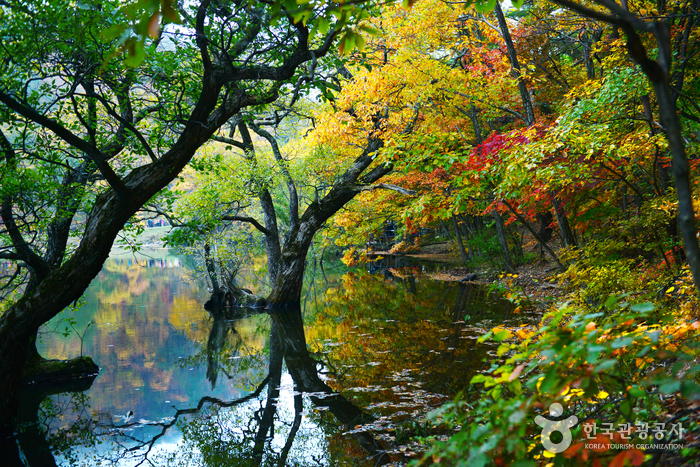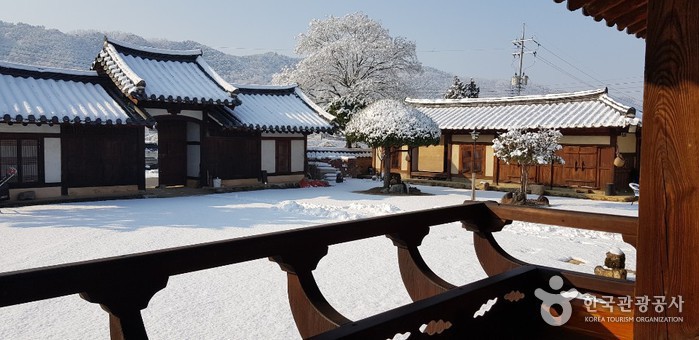Embalse Jusanji (주산지 (청송 국가지질공원))
16.6Km 2024-03-25
Jusanji-ri, Juwangsan-myeon, Cheongsong-gun, Gyeongsangbuk-do.
El embalse Jusanji es un pequeño espejo de agua situado en el Parque Nacional del Monte Juwangsan. Es un embalse artificial que fue creado en agosto de 1720 y terminado en octubre del año siguiente. Ha sido utilizado como fuente de agua para uso agrícola, así como para agua potable. Incluso aunque es de tamaño pequeño, de unos 100 metros de largo, 50 metros de ancho y 7 u 8 metros de profundidad, nunca se ha secado por ninguna sequía. Los espesos bosques circundantes del monte Juwangsan son un lugar bastante impresionante para aquellos que amen la naturaleza. Hay 30 sauces que tienen 150 años y están arraigados en el embalse, lo cual hace un equilibrio fantástico con el entorno, creando un paisaje pintoresco que no se encuentra en ningún otro lugar. La belleza de este bosque junto con la naturaleza circundante culmina cuando las sombras de los árboles se alargan sobre las aguas mansas. Las palabras no pueden expresar la vista magnífica de los alrededores, con el agua, los árboles y la niebla en conjunto.
Las mejores estaciones para visitar Jusanji son la primavera y el otoño. La gente dice que la mejor época para ir es cuando los brotes primaverales comienzan a aparecer en abril y mayo, o cuando el follaje otoñal está en todo su esplendor. En el verano, se extrae mucha agua para la agricultura, así que el área parece vacía, y en el invierno, el embalse está helado y no es posible ver los reflejos de los árboles sobre el agua.Jusanji está situado en la parte interior del monte Juwangsan, la cual, a diferencia de la parte exterior, en donde las rutas de senderismo están más desarrolladas, había sido considerada como recóndita debido a su inaccesibilidad y a sus montañas escarpadas. Comenzó a volverse famosa para el público en general hace unos 20 años cuando los fotógrafos llegaron buscando paisajes hermosos. En el último tiempo, el número de visitantes ha aumentado abruptamente, después de que el director de cine Kim Ki-duk mostrara las pintorescas cuatro estaciones del lago en la película Spring, Summer, Fall, Winter and Spring (Primavera, verano, otoño, invierno y primavera). Incluso aunque el plató cinematográfico fue desmantelado por razones medioambientales y de administración, para prevenir la contaminación del agua, numerosos visitantes continúan llegando al lugar.
Oryuheon House / 오류헌
17.0Km 2025-08-12
18-15, Gireumaje-gil, Andong-si, Gyeongsangbuk-do
Oryuheon House, located near Imhaho Lake in Andong, Gyeongsangbuk-do, offers a chance to stay in a historic house from the Joseon period. The house, also known as Mogwa House, was built by Kim Won-jung, the third son of Sukjong-era rector of the National Academy Kim Bang-geol, when he formed a family of his own in 1678. It was designated as the National Folk Cultural Heritage No. 184. The door’s wooden frame and the open floor space exemplify the beauty of the literati house of the Joseon period, while the sarangchae (men’s quarters) and daemunchae (gate quarters) showcase the sophisticated architecture of the era. Anchae (women’s quarters) retains its original appearance, while the sarangchae was rebuilt in 1920. The construction of the Imha Dam in 1990 resulted in the house’s relocation to its present location.
The owner of the house resides in anchae and sarangchae. Guests have access to a space that includes a 2-kan room, which can accommodate up to 4, an open floor space, and a bathroom. Cooking is prohibited in the house, but guests can make use of a grill located on a small yard reserved for the guests. Korean-style breakfast, including menus like chicken porridge or lotus leaf rice, are offered free of charge in the morning. Nearby sights include the water sports activities in Imhaho Lake, Manhyujeong Pavilion, Hahoe Village, and Dosanseowon Confucian Academy.


 Español
Español
 한국어
한국어 English
English 日本語
日本語 中文(简体)
中文(简体) Deutsch
Deutsch Français
Français Русский
Русский